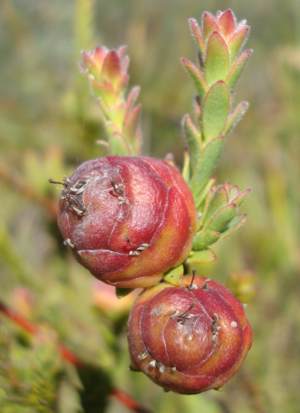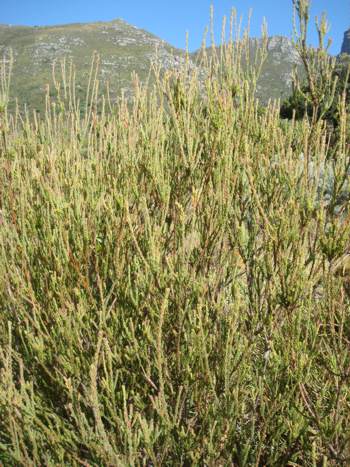Leucadendron thymifolium
Leucadendron thymifolium (Salisb. ex Knight) I.Williams
Family: Proteaceae
Common names: Malmesbury conebush, thymeleaf protea; katsterttolbos, swartveldknoppiesbos (Afr.)
Introduction
Leucadendron thymifolium is a Critically Endangered plant and experts predict this species could be extinct by 2025.

Description
Description
Leucadendron thymifolium is a shrub that reaches a maximum height of 2m. At the base it has a single stem branching into slender upright stems further up. Stems are hairy when young and become smooth at maturity. Leaves are elliptic to oblong. The leaves on male plants are much smaller than the leaves on female plants making it hard to see that they are in fact the same species. This does make it easy if you are buying plants from a nursery and are looking specifically for male or female plants.

Flowering occurs in late winter and early spring (August to September). The bright yellow male flowers resemble little powder puffs and are full of pollen. They are 17mm in diameter and have a yeasty smell. Female flowers are also bright yellow owing to the stigmas (the receptive vessels) receiving and becoming covered with pollen. The female flowers are 13mm in diameter. After successful pollination, the female flowers develop a cone that holds the seeds. These cones grow to 18mm in diameter. Seeds are light brown nuts and are fully ripe 5 months after flowering.

Similar species and their differences are:
- Leucadendron stellare is a resprouter and has many stems rising from the base whereas L. thymifolium has a single stem in most cases.
- Leucadendron cinereum and L. levisanus are both serotinous species (i.e., they keep their seeds enclosed within the female cones) whereas L. thymifolium releases its seeds once they are ripe.
Conservation Status
Status
Leucadendron thymifolium is Red Listed as Critically Endangered. The decreasing numbers of plants are due to habitat loss through alien plant invasion, and urban and agricultural expansion. Much of the current population occurs along road verges outside of protected areas which are prone to damage by roadside mowing and clearing.
Plants have been propagated and planted at Kirstenbosch National Botanical Garden to serve as an ex situ conservation collection.
Distribution and habitat
Distribution description
The Malmesbury Conebush occurs in a small area along the Malmesbury flats from Dassenberg to Klipheuwel. It grows in sandy or gravel soils that overlie clay at an altitude of about 100m above sea level.
Derivation of name and historical aspects
History
The Proteaceae family is large and consists of about 1400 species worldwide. The genus Leucadendron contains about 83 species, which, apart from a single outlying species and two outlying subspecies, are all confined to the southern and southwestern part of the Western Cape.
The genus name is composed of leucos, meaning white, and dendron, meaning tree. This refers to the iconic silvertree (Leucadendron argenteum) on which the genus name was based. Early Dutch settlers originally referred to the silvertree as the witteboom or 'white tree'.
The specific epithet, thymifolium, refers to the resemblance of the leaves to those of the well-known culinary herb, thyme.
Ecology
Ecology
All fynbos plants have adapted to survive in a fire-driven ecosystem and employ one of two strategies: reseeding or resprouting.Leucadendron thymifolium is an example of a reseeder. Year after year, many seeds are produced that drop to the ground and become buried amongst the leaf litter. When a fire occurs, all mature plants are killed. The fire, smoke, rainfall and fluctuating temperatures all provide germination triggers for the seed lying dormant in the soil. New seedlings grow and establish a new and healthy population of plants.
Uses
Use
There are no known recorded cultural or medicinal uses for the Malmesbury conebush. It is not widely cultivated in horticulture.

Growing Leucadendron thymifolium
Grow
The Malmesbury conebush has finely textured foliage with lanky tall stems. It is suited to an informal fynbos garden where it can be planted in amongst other plants with larger more dense foliage. In spring the tall flowering stems are very attractive. It requires a spot in full sun with well-drained soil and regular water. The Malmesbury conebush is easy to grow and establish in a garden and simply requires an annual feeding of well-decomposed compost. Prune lightly to neaten bushes.

Propagate plants from either cuttings or seed. Sowing seed is the easier method and requires no specialist equipment.
Make cuttings from December to March (summer to autumn). The cuttings should be semi-hardwood, 60-100mm long, and taken from the current season's growth. Dip the cuttings into a rooting hormone solution or powder and plant them into a medium of 50% polystyrene and 50% finely milled pine bark. Place in a growing house with bottom heat (25°C). Once the roots are well-developed, remove from bottom heat and harden the cuttings off for three weeks. Plant the individual cuttings into small bags and grow on until ready to plant into the garden.
Sow seed in April when the days are warm and the nights start to cool down (late summer to autumn). Dust the seed with a systemic fungicide. Sow on a well-drained medium, firm down and cover with a layer of sand or finely milled bark. Seed can be sown in an open seedbed, or in a seed tray placed in a sunny position. Germination begins after two to three weeks. Once two true leaves have grown, prick the seedlings out and plant into small bags. Place the seedlings in a lightly shaded area with good air circulation. When plants are ±50-100mm tall, or after one year's growth, they can be planted into the garden.
You can also sow seed directly where you want the plants to grow. Plant, cover lightly with soil, and water.
Once members of the Protea family become diseased they are very difficult to treat, and it is better to prevent disease, rather than try to cure it. Make sure your environmental conditions are correct. This includes getting direct sunlight for most of the day, a sandy well-drained soil, and good air circulation ensuring that the aboveground parts of the plant dry quickly after watering. It is also important to ensure that the soil stays cool in the hot months and that roots are not disturbed by digging. A thick layer of mulch or surrounding planting can be used to keep the soil cool and prevent moisture loss. If any of these factors are out of balance, plants become weak and stressed, and generally become infected with pests or disease.
References
- iSpot, your place to share nature. http://www.ispot.org.za/
- Rebelo , A. 2001. Proteas . A field guide to the proteas of southern Africa , edn 2. Fernwood Press, Cape Town.
- Rebelo , A.G., Helme , N.A., Holmes, P.M., Forshaw, C.N., Richardson, S.H., Raimondo , D., Euston-Brown, D.I.W., Victor, J.E., Foden, W., Ebrahim, I., Bomhard, B., Oliver, E.G.H., Johns, A., Van der Venter, J., Van der Walt, R., Von Witt, C., Low, A.B., Paterson-Jones, C., Rourke, J.P., Hitchcock, A.N., Potter, L., Vlok, J.H. & Pillay, D. 2006. Leucadendron thymifolium (Salisb. ex Knight) I.Williams. National Assessment: Red List of South African Plants. http://redlist.sanbi.org/
- Williams, I.J.M. 1972. A revision of the genus Leucadendron (Proteaceae ). Contributions from the Bolus Herbarium 3. University of Cape Town, Cape Town.
Credits
Louise Nurrish
Kirstenbosch National Botanical Garden
February 2014
Plant Attributes:
Plant Type: Shrub
SA Distribution: Western Cape
Soil type: Sandy, Clay, Loam
Flowering season: Spring, Winter
PH: Acid, Neutral
Flower colour: Red, Yellow
Aspect: Full Sun
Gardening skill: Average
Special Features:
Horticultural zones







Rate this article
Article well written and informative
Rate this plant
Is this an interesting plant?
Login to add your Comment
Back to topNot registered yet? Click here to register.